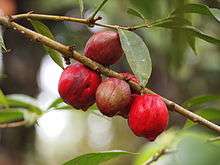Phaleria macrocarpa
| Phaleria macrocarpa | |
|---|---|
 | |
| Ripe Phaleria macrocarpa | |
| Scientific classification | |
| Kingdom: | Plantae |
| (unranked): | Angiosperms |
| (unranked): | Eudicots |
| (unranked): | Rosids |
| Order: | Malvales |
| Family: | Thymelaeaceae |
| Genus: | Phaleria |
| Species: | P. macrocarpa |
| Binomial name | |
| Phaleria macrocarpa (Scheff.) Boerl. | |
Phaleria macrocarpa (Buah Mahkota Dewa, God's Crown, Pau) is a dense evergreen tree, indigenous to Indonesia and Malaysia. It is found in tropical areas of New Guinea up to 1,200 meters above sea level.
Botany
P. macrocarpa's height ranges from 1 to 18 meters with greenish bark and white wood. It has green, tapered leaves. The flowers are made up to two to four petals, and range from green to maroon in color. It grows 10-1,200 m above sea level with a productive age that ranges from 10 to 20 years. The leaves are green and tapering with length and width ranging from 7 cm to 10 cm and 3-5 cm respectively. The flowers make a compound of 2-4, with color from green to maroon. Eclipse shaped fruits are green when unripe, and have a diameter of 3 centimeters. They are red when ripe. The white, round pits are poisonous[1] and fruit is of eclipse shape with a diameter of 3 cm. Each fruit has 1 to 2 brown, ovoid and anatropous seeds per fruit. The extract of the plant has been evaluated scientifically for pharmacological uses.[1]
Uses
Extracts of P. macrocarpa have been reported[2] to have a number of pharmacological effects, including:
- anti-tumor
- anti-hyperglycemia
- anti-inflammation
- anti-diarrhoeal
- anti-oxidant
- anti-viral, anti-bacterial and anti-fungal
- vasodilator
The stem and shells of seeds have been used to treat various cancers, lung, live and heart diseases.[3]
The leaves also contain compounds that can treat impotence, blood diseases, allergies, diabetes mellitus and tumors.[4] Moreover, Its leaves also showed antihypercholesterolemia activity and antiatherosclerosis potency through increasing of SR-BI expression.They also reported that P. macrocarpa leaves are safe and suitable as an alternative control and prevention treatment for hypercholesterolemia in Sprague dawley rats.[5]
Origin: New Guinea, Indonesia.
- Young fruit of Phaleria macrocarpa in Malaysia
 The split fruit.
The split fruit.- Ripened fruits falls to ground
- Seedlings of Phaleria macrocarpa growing under the parent tree
References
- ↑ Altaf, Rabia; Asmawi, MohammadZaini Bin; Dewa, Aidiahmad; Sadikun, Amirin; Umar, MuhammadIhtisham. "Phytochemistry and medicinal properties of Phaleria macrocarpa (Scheff.) Boerl. extracts". Pharmacognosy Reviews. 7 (1): 73. doi:10.4103/0973-7847.112853.
- ↑ Hendig, Winaro; Ermin, Katrin W (2010). "BENZOPHENONE GLUCOSIDE ISOLATED FROM THE ETHYL ACETATE EXTRACT OF THE BARK OF MAHKOTA DEWA [Phaleria macrocarpa (Scheff.) Boerl.] AND ITS INHIBITORY ACTIVITY ON LEUKEMIA L1210 CELL LINE". Indonesian Journal of Chemistry. 9 (1): 142–145. Retrieved 29 July 2014.
- ↑ Hendra, Rudi; Ahmad, Syahida; Oskoueian, Ehsan; Sukari, Aspollah; Shukor, M Yunus. "Antioxidant, Anti-inflammatory and Cytotoxicity of Phaleria macrocarpa (Boerl.) Scheff Fruit". BMC Complementary and Alternative Medicine. 11 (1): 110. doi:10.1186/1472-6882-11-110.
- ↑ Saufi, Ahmad (2007). Lignans in Phaleria macrocarpa (Scheff.) Boerl. and in Linum flavum var. compactum L. Aachen: Shaker. ISBN 3832267514.
- ↑ Andriani, Yosie; Tengku Muhammad, Tengku Sifzizul; Mohamad, Habsah; Saidin, Jasznizat; syamsumir, Desy Fitrya; Chew, Guat-Siew; Effendy, Abdul Wahid Mohd.(2015). "Phaleria macrocarpa Boerl. (Thymelaeaceae) Leaves Increase SR-BI Expression and Reduce Cholesterol Levels in Rats Fed a High Cholesterol Diet". Molecules. 20 (3): 4410–4429. doi:10.3390/molecules20034410.
![]() Media related to Phaleria macrocarpa at Wikimedia Commons
Media related to Phaleria macrocarpa at Wikimedia Commons